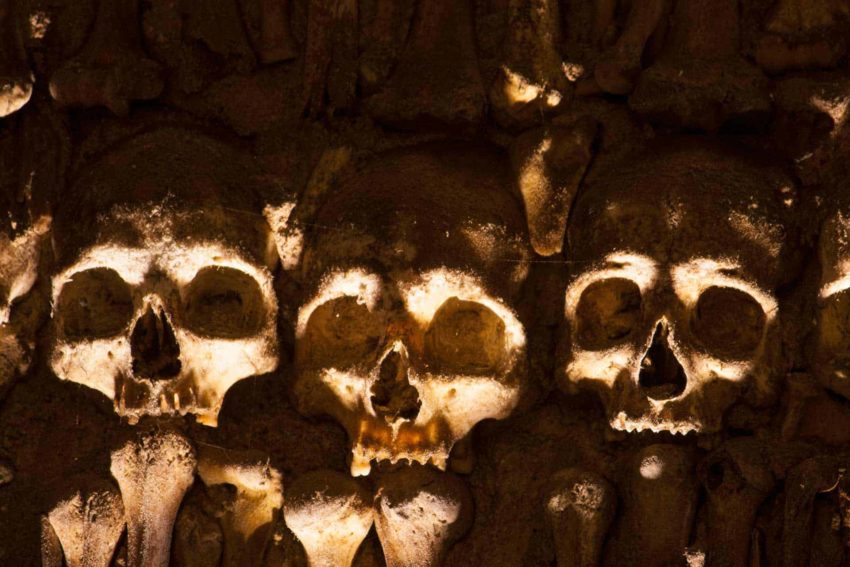The Chapel of Bones in Evora is one of the most unusual things to see in Portugal. It’s a chapel decorated entirely with human bones, including skulls, tibias and femurs. It’s attached to the much more cheery Church of São Francisco in the historic heart of Evora.
The city is one of the most compelling places to visit in Portugal, with prehistoric, Roman, Moorish and Portuguese pasts to discover. Yet when we visited the only time we encountered any sort of crowd was in the Chapel of Bones. Death always exerts a strong fascination, and here it’s staring you in the face, 5,000 times over.
The Capela dos Ossos Evora was begun in the 16th century. The burial grounds of the city were full to capacity, and there was nowhere to expand. The solution? Exhuming the bones of the dead and storing them together in one place.
The bones in the Capela also served another purpose. The Church’s most powerful message is that life is brief and transitory, that all humans will meet the same fate. So a monumental stack of thousands of bones was ideal for conveying this memento mori.
You could call it killing two birds with one, erm, bone. Sorry. Couldn’t resist.
What to See at the Chapel of Bones ?
In a word, bones. The bones seem to form the very fabric of the building, but they’re actually aided by cement. They cover the walls and pillars of the chapel, and are also used to decorate the ceiling vault.
The inscription above the Chapel of Bones entrance translates as, ”Our bones await your bones.” A poem also hangs on one of the pillars of the church. The first stanza asks, ”Where are you going in such a hurry, traveller? Stop…..You have no greater concern than this one.”
Nobody would have known that they were going to end up on display into the 21st century. The likelihood is that they were people from the Evora area, most likely a cross-section of society. The two things they all had in common were that they were dead and there wasn’t enough space for them in the ground.
However, it gets even more macabre: two desiccated corpses dangle from the ceiling, the ultimate indignity. One of them is significantly smaller than the other, so it’s likely that one is a child. I could see that they were trying to convey the message that all things temporal are temporary, but this is just gruesomely bad taste.
What happend to the Chapel Builders ?
They indeed went the way of all flesh, but not the way of the 5,000 or so in the chapel. It was fine for them to line the walls and roof of the chapel, but the three monks did not donate their bones to the ossuary upon their demise. They chose to lie in a white coffin in the chapel instead.
Is This The Only Bone Church In Portugal ?
No, however it is the best-known example in the country. There is also a Capela dos Ossos in Faro, the Algarve capital, adjacent to the Carmelite Church (Igreja do Carmo). There is also another ossuary in the Alentejo region, at Campo Maior, near the border town of Elvas.
Are There Other Ossuaries in Europe ?
Yes, indeed they are. And at some of them you’ll see more than just bones.
The Catacombs of Paris are believed to contain the bones of over six million people. This is a vast underground network of tunnels, and you visit a small section (1.5 km, or 0.9 mile).
The Sedlec Ossuary is in a chapel in the Czech town of Kutná Hora. The bones of at least 40,000 people are held there. The decorations are more imaginative and elaborate than those at Evora, and include a chandelier made out of bones.
Several Capuchin convents in Italy host the dead in crypts. One of the best known is the Convento dei Cappuccini in Palermo, Sicily. Here, bodies are propped up standing in their niches, dressed in all their finery. They were all embalmed, although the success of the process varies greatly! The result is a series of macabre grotesque figures stuck in their bizarre poses for eternity.
How to Visit the Chapel of Bones Evora
The Chapel of Bones in Evora is located in the precincts of Sao Francisco Church on Praça 1 de Maio in Evora.
It’s open between 0900 and 1700 daily between November and March. It’s then open 0900 to 1830 daily April to October.
Entry costs €4.00, which also includes admission to an exhibition on religious art.
Source link
